Rocky Mountain Arctic Blue
Plebejus glandon rusticus
Classification
- Phylum: Arthropoda
- Subphylum: Hexapoda
- Class: Insecta
- Order: Lepidoptera
- Superfamily: Papilionoidea
- Family: Lycaenidae
- Subfamily: Polyommatinae
- Genus: Plebejus
- Species: glandon
- Subspecies: rusticus
Pronunciation
How to pronounce Plebejus glandon rusticus: /ˈple.bɛ.jus ˈɡlan.dɔn ˈrʊs.ti.kus/
These audio files are automatically generated. While they are not always 100% accurate, they are a good starting point.
Images
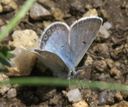
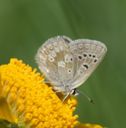
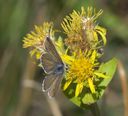
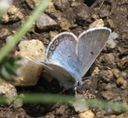
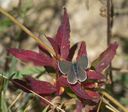
Summary
Plebejus glandon rusticus is recognized as a subspecies of the Arctic blue butterfly, found primarily in North America and notable for its distinct wing coloration and larval food sources, inhabiting mountainous and tundra environments.
Physical Characteristics
Wingspan of 17–26 mm. Male upper wings are silver-coloured, steely blue or pale shining blue, becoming brown towards the edges. Female upper wings are mostly brown with a slightly bluish coloration in the basal area. All wings have small dark disk spots, some with white surrounds. The forewing undersides are pale grey-brown with white-rimmed black dots, while hind wings have striking white spots and occasional orange dots on a greyish-brown ground.
Identification Tips
Distinguishable from other bluish species by its geographic variability and specific features such as white-rimmed black dots on the forewing underside and distinctive hindwing markings. In regions like the Alps and Pyrenees, it can be confused with Aricia nicias and Agriades pyrenaicus due to overlapping ranges.
Habitat
Found in arctic tundra, subarctic and subalpine forests, mountain meadows, and bogs.
Distribution
Range extends from Alaska east to Newfoundland, south through mountains to Washington, northern Arizona, and northern New Mexico, as well as areas in the Pyrenees, Alps, and parts of Russia including Siberia and Kamchatka.
Diet
Larval food plants include Androsace species (A. alpina, A. chamaejasme, A. lactea, A. laggeri, A. obtusifolia, A. villosa, A. vitaliana), Soldanella species, and Oxytropis campestris. Other recorded plants include Androsace bungeana, Androsace septentrionalis, Diapensia lapponica, Vaccinium, and several Saxifraga species.
Life Cycle
Flies from mid-May to September depending on location.
Reproduction
Details regarding reproduction are not provided in the data.
Similar Taxa
- A. g. glandon
- A. g. aquilo
- A. g. franklinii
- A. g. wosnesenskii
- A. g. aquilina
- A. g. rustica
- A. g. megalo
- A. g. bryanti
- A. g. lacustris
- A. g. centrohelvetica
- A. g. punctatus
- A. g. cassiope
- A. g. kelsoni
- A. g. ustjuzhanini
- A. g. saluki
- A. g. brutus
- A. g. rubini
- A. g. batchimeg
- A. g. labrador
Misconceptions
Some variations are treated as separate species while others are combined under Agriades franklinii, which can lead to confusion regarding classification.
Tags
- butterflies
- Lepidoptera
- North America
- mountain habitats
- taxonomy